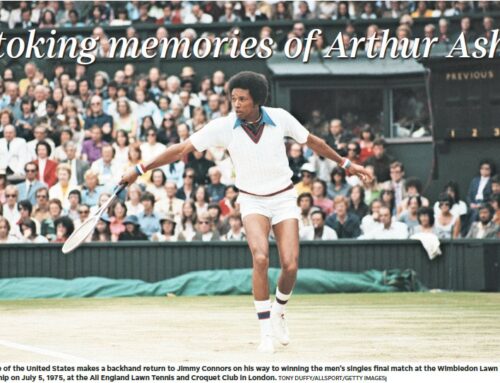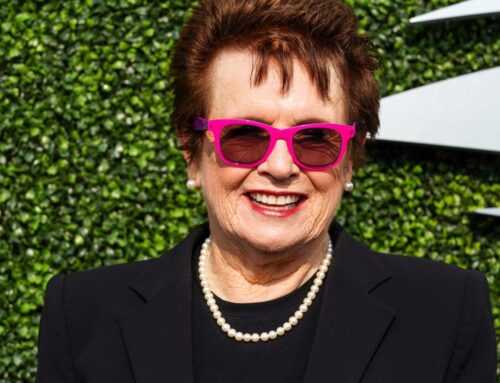For only the third time in its 55-year history, the International Tennis Hall of Fame (ITHF) opened its doors to an African American member. Althea Gibson broke the racial barrier in 1971,followed by Arthur Ashe in 1984, and just last week, Dr. R. Walter (Whirlwind) Johnson, the man most responsible for launching the incredible careers of Gibson and Ashe, fittingly took his long-delayed but well-earned space of honor last weekend at the Newport, RI facility. The late Lynchburg, Va. physician was the first African American to be inducted as a contributor.
Scores of his American Tennis Association (ATA) friends, former juniors and admirers, including a busload from New York, felt obliged, indeed compelled, to be among the crowd when Dr. Johnson’s grandson, Lange, accepted the honor in behalf of the family. Lange’s eloquent acceptance speech was appropriately preceded by a moving introduction by the ever serene and inspiring Jeanne Moutoussamy Ashe, Arthur’s widow. She described Dr. Johnson and Ashe as kindred spirits in their efforts to shape a better world.
Patricia Koger, who years ago was among several hundred African American juniors players inspired by Dr. Johnson’s determination, wisdom and generosity, summarized the ecstasy shared by many at his induction this way: “Our anticipation of this historic event; the sweet smiles, laughter and fun; an endless flow of memories; the well wishes and prayers from near and far, made for a joyful noise. Even now, days later, I can hear it in my heart. Thanks to the ITHF for bestowing this tremendous honor and to all who contributed to the elegance of the occasion.”
I, too, salute ITHF leaders – president Tony Trabert and CEO Mark Stenning for continuing to push for Dr. Johnson’s induction, despite earlier resistance from a sizeable segment of Hall of Fame Committee voting members. Let no one think for a moment that Dr. Johnson’s induction was a slam dunk decision. Not by a long shot. I thought it would be useful to share details of a get-Dr. J-inducted campaign that I began nearly 10 years ago and to recognize some of those ‘good people,’ who helped make it possible. First, a little background.
I know of Dr. Johnson’s meritorious service not from what others have said, but rather from what I saw and experienced as a member of his junior development team in 1960. No one did more to change the face, if not the heart of the tennis world, during that time than the soft-spoken, tough-as-nails physician. Years later, when I learned that he had operated his ATA junior development program on his backyard court for more than 20 years, I decided that his was a story to be shared with tennis lovers everywhere. I completed and self-published the Dr. J biography – entitled Whirlwind, the Godfather of Black Tennis – in 2004. (For the record, it was a family affair; my wife, Anne, and sons, Jerome and Jared, worked overtime.
It soon became clear that it would take more than writing a book and getting Dr. Johnson features published in various tennis magazines to get the ITHF to take note. Indeed, it took what one friend called a “village of good people” to make Dr. Johnson’s induction a reality. There were several obstacles to overcome and frustrations to endure, beginning with the paperwork.
In order to be considered for induction, an application outlining the nominee’s record of achievement must be submitted a year prior to the ceremony. The ITHF nominating committee meets at Wimbledon each year to select the nominees to be placed on the ballot for consideration. The committee’s selections are announced two months later at the U.S. Open and voting must be completed by mid-December. A nominee must receive 75% of the vote to be inducted.
My first application recommending Dr. Johnson, filed more than six years ago, never reached the nominating committee. In 2006 I informed Alan Schwartz, then-past president of the U.S. Tennis Association, of the snub. That same year, he volunteered to submit another Dr. Johnson application under his signature. Schwartz also sent personal messages to all the voting members, encouraging them to support this nominee. Dr. Johnson’s name was among those on the 2006 ballot, but he fell short of the required 75% needed for induction.
Johnson family members were assured that he would be placed on the ballot in 2007, but he wasn’t. Tennis historian Bud Collins, a long-time friend and ESPN analyst, didn’t attend the 2007 Wimbledon nominating committee meeting that year, but he was there in 2008. Collins, one of the tennis world’s most beloved ambassadors, pushed for Dr. Johnson to be considered despite strong resistance. “Many of the European members asked, ‘Who is this guy?'” said Collins, also a Hall of Famer. “They say they don’t know him.”
Because of Collins’s strong personal recommendation and persistence, Dr. Johnson again appeared on the ballot in 2008, and again Schwartz sent please-support-Dr. Johnson messages to ITHF voting members. This time, some came around.
Other good folks also lent a hand.
Last fall, Page Crosland, a former USTA director of communications, used her connections to add a political element of support. Thanks to Crosland, Cong. John Lewis, a noted Civil Rights leader who was severely beaten by a white Montgomery, Ala. mob during a Civil Rights march in the spring of 1961, wrote a tribute to Dr. Johnson that was published in the Congressional Record. Lewis called Dr. Johnson, “an unsung sports hero.” Lewis’s tribute and the election of Barack Obama as the first African American U.S. president, weeks earlier, I believe, helped align the stars that created Dr. Johnson’s special moment in the sun.
I would be remiss if I didn’t include the efforts of tennis great John McEnroe, who called for Johnson’s induction in the foreword of my Dr. Johnson biography. Wimbledon champion Serena Williams was among several pros who also publicly supported Dr. Johnson.
Actually, to a certain degree, the European ITHF members opposing Dr. Johnson had a point; The mainstream tennis community – in the U.S. as well as abroad – still knows very little about Dr. Johnson or the history of the ATA, the nation’s oldest African American sports organization, which was founded in 1916. Next time, I’ll discuss some things I believe the ATA and USTA should do about that.





Leave A Comment